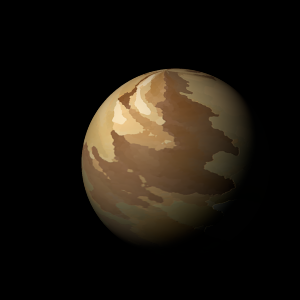|
|
Space Astro
|
Info for exoplanet "Yurwamwen"
| Scientific (actual) data |
|---|
| Planet | HD 177830 A c |
| Planet status | Confirmed |
| Mass sini | 0.15 |
| Orbital period | 110.9 |
| Semi major axis | 0.5137 |
| Orbit eccentricity | 0.3495 |
| Angular distance | 0.008707 |
| Discovered | 2010 |
| Updated | 2019-12-13 |
| Omega | 110 |
| Tperi | 10179 |
| Publication | Published in a refereed paper |
| Detection type | Radial Velocity |
| Alternate names | HD 177830 c |
| Star name | HD 177830 A |
| Right ascension | 286.33° |
| Declination | 25.92° |
| Mag v | 7.18 |
| Star distance | 59 |
| Star metallicity | 0.55 |
| Star mass | 1.47 |
| Star radius | 2.99 |
| Star sp type | K0IV |
| Star age | 4.4 |
| Star temperature | 4948 |
| Star alternate names | HD 177830 |
| Wikipedia article | HD 177830 A c |
Back
| |
| Fictional info (?) |
|---|
| Suggested name | Yurwamwen |
| Planet type | Cold planet |
| It is named after the deity Yurwamwen, the goddess of fear.
It may have had methane oceans in the past, but these would have vaporized as the temperature rose due to a runaway greenhouse effect.
Optical ground-based telescopes are typically limited to resolving features about 480 kilometers across when Yurwamwen is closest because of Earth's atmosphere.
This nice place is said to have small primordial technological beings known to spend their life on the surface by devouring plants. They are similar to the Yaoqyow and have scales and vary in length from 80 to 90 mm. Cowai are known to live at temperatures from 30 to 90°C and even extreme gravity which is common on Yurwamwen. |
| Estimated population | 1.0E-6 |
| Atmosphere | Water | 95% |
| Oxygen | 2.3% |
| Methane | 1.7% |
| Carbon dioxide | 0.13% |
| Atmospheric pressure | 30 bar |
 |
| No known satellites |
| Google search for Yurwamwen |
|
Website by Joachim Michaelis
|
|
|
|